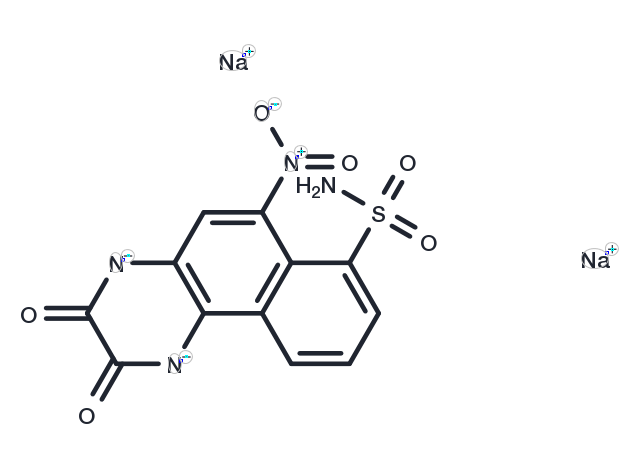Powder: -20°C for 3 years | In solvent: -80°C for 1 year


NBQX Disodium (FG9202 disodium) is a highly selective, competitive AMPA receptor antagonist with neuroprotective and anticonvulsant activity. NBQX Disodium is a salt of NBQX. NBQX is a potent and selective AMPA/rhodosinate receptor antagonist that can be used to antagonize the excitatory toxicity of glutamate. It has anticonvulsant effects in rodent models.

| Pack Size | Availability | Price/USD | Quantity |
|---|---|---|---|
| 1 mg | In stock | $ 62.00 | |
| 5 mg | In stock | $ 117.00 | |
| 10 mg | In stock | $ 145.00 | |
| 25 mg | In stock | $ 329.00 | |
| 50 mg | In stock | $ 488.00 | |
| 100 mg | In stock | $ 713.00 |


| Description | NBQX Disodium (FG9202 disodium) is a highly selective, competitive AMPA receptor antagonist with neuroprotective and anticonvulsant activity. NBQX Disodium is a salt of NBQX. NBQX is a potent and selective AMPA/rhodosinate receptor antagonist that can be used to antagonize the excitatory toxicity of glutamate. It has anticonvulsant effects in rodent models. |
| Targets&IC50 | AMPA:0.7 ± 0.1 μM, Kainic acid:0.7 ± 0.03 μM |
| In vitro | In HIP-009 cells, NBQX disodium salt inhibited both AMPA or kainic acid (KA) induced signals in a concentration-dependent manner, with IC50 values being 0.7 ± 0.1 and 0.7 ± 0.03 μM, respectively. The AMPA-evoked calcium rise was completely inhibited by NBQX disodium salt, whereas 68.6% ± 1.3% inhibition of the KA-induced signal was observed with 30 μM of NBQX disodium salt treatment.[1] |
| In vivo |
Administration of NBQX disodium (FG9202; 20 mg/kg, i.p.; for 3 days) exhibits a reduction in PTZ-induced seizures. [2] In a rat model of focal ischemia, NBQX disodium demonstrates neuroprotective effects when administered intravenously as a bolus dose of 30 mg/kg at the time of MCA occlusion, followed by an additional dose at 1 hour post-occlusion. [3] |
| Synonyms | FG9202 disodium, NBQX 2Na |
| Molecular Weight | 380.24 |
| Formula | C12H6N4Na2O6S |
| CAS No. | 479347-86-9 |
Powder: -20°C for 3 years | In solvent: -80°C for 1 year
H2O: 34.2 mg/mL(90.0 mM), Sonication is recommended.
You can also refer to dose conversion for different animals. More
bottom
Please see Inhibitor Handling Instructions for more frequently ask questions. Topics include: how to prepare stock solutions, how to store products, and cautions on cell-based assays & animal experiments, etc.
NBQX Disodium 479347-86-9 Neuroscience GluR FG 9202 FG9202 disodium FG-9202 NBQX NBQX 2Na FG9202 inhibitor inhibit
